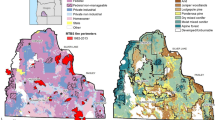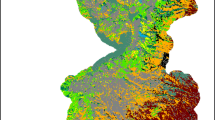Abstract
Though fire is considered a “natural” disturbance, humans heavily influence modern wildfire regimes. Humans influence fires both directly, by igniting and suppressing fires, and indirectly, by either altering vegetation, climate, or both. We used the LANDIS disturbance and succession model to compare the relative importance of a direct human influence (suppression of low intensity surface fires) with an indirect human influence (timber harvest) on the long-term abundance and connectivity of high-risk fuel in a 2791 km2 landscape characterized by a mixture of northern hardwood and boreal tree species in northern Wisconsin. High risk fuels were defined as a combination of sites recently disturbed by wind and sites containing conifer species/cohorts that might serve as “ladder fuel” to carry a surface fire into the canopy. Two levels of surface fire suppression (high/current and low) and three harvest alternatives (no harvest, hardwood emphasis, and pine emphasis) were compared in a 2×3 factorial design using 5 replicated simulations per treatment combination over a 250-year period. Multivariate analysis of variance indicated that the landscape pattern of high-risk fuel (proportion of landscape, mean patch size, nearest neighbor distance, and juxtaposition with non fuel sites) was significantly influenced by both surface fire suppression and by forest harvest (p > 0.0001). However, the two human influences also interacted with each other (p < 0.001), because fire suppression was less likely to influence fuel connectivity when harvest disturbance was simultaneously applied. Temporal patterns observed for each of seven conifer species indicated that disturbances by either fire or harvest encouraged the establishment of moderately shade-tolerant conifer species by disturbing the dominant shade tolerant competitor, sugar maple. Our results conflict with commonly reported relationships between fire suppression and fire risk observed within the interior west of the United States, and illustrate the importance of understanding key interactions between natural disturbance, human disturbance, and successional responses to these disturbance types that will eventually dictate future fire risk.
Similar content being viewed by others
References
Aber J.D. and Melillo J.M. 1991. Terrestrial Ecosystems. Saunders College Publishing, Philadelphia, Pennsylvania, USA, 429 pp.
Almendinger J.C. and Hanson D.S. 1998. Ecological land classification handbook for the northern Minnesota Drift and Lake Plain and the Chippewa National Forest. Minnesota Department of Natural Resources.
Borman F.H. and Likens G.E. 1979. Catastrophic disturbance and the steady state in northern hardwood forests. American Scientist 67: 660–669.
Burns R.M. and Honkala B.H. 1990. Silvics of North America: 1. Conifers; 2. Hardwoods. Agriculture Handbook 654. U.S. Department of Agriculture, Forest Service, Washington, DC, USA, 877 pp.
Canham C.D., and Loucks O.L. 1984. Catastrophic windthrow in the presettlement forests of Wisconsin. Ecology 65: 803–809.
Cardille J.A. and Ventura S.J. 2001. Occurrence of Wildfire in the Northern Great Lakes Region: Effects of Land Cover and Land Ownership Assessed at Multiple Scales. International Journal of Wildland Fire 10: 145–154.
Cardille J.A., Ventura S.J., and Turner M.G. 2001. Environmental and Social Factors Influencing Wildfires in the Upper Midwest, United States. Ecological Applications 11: 111–127.
Cleland D.T., Crow T.R., Saunders S.C., Dickmann D.I., Maclean A.L. and Brosofske K.D. 2004. Characterizing historical and modern fire regimes in the Lakes States: A landscape ecosystem approach. Landscape Ecology 19: this issue.
Cleland D.T., Avers P.E., McNab W.H., Jensen M.E., Bailey R.G., King T., and Russell W.E. 1997. National Hierarchical Framework of Ecological Units. In: Boyce M.S. and Haney A. (eds), Ecosystem Management: Applications for Sustainable Forest and Wildlife Resources. Yale University Press, New Haven, Connecticut, USA, pp. 181–200.
Cumming S.G. 2001. Forest type and wildfire in the Alberta boreal mixedwood: What do fires burn? Ecological Applications 11: 97–110.
Curtis J. T. 1959. The vegetation of Wisconsin. University of Wisconsin Press, Madison, Wisconsin, USA.
Frelich L.E. and Reich P.B. 1995. Neighborhood effects, disturbance, and succession in forests of the western Great Lakes region. Ecoscience 2: 148–158.
Frelich L.E. and Reich P.B. 1999. Neighborhood effects, disturbance severity, and community stability in forests. Ecosystems 2: 151–166.
Frelich L.E. and Lorimer C.G. 1991. Natural Disturbance Regimes of the Upper Great Lakes Region. Ecological Monographs 61: 145–164.
Gustafson E.J., Shifley S.R., Mladenoff D.J., Nimerfro K.K., and He H.S. 2000. Spatial Simulation of Forest Succession and Timber Harvesting Using LANDIS. Canadian Journal of Forest Research 30: 32–43.
Gustafson E.J. 1998. Quantifying landscape spatial pattern: What is the state of the art? Ecosystems 1: 143–156.
Gustafson E. J., Zollner P.A., He H.S., Sturtevant B.R., and Mladenoff D. J. 2004. Influence of forest management alternatives and land type on susceptibility to fire in northern Wisconsin, USA. Landscape Ecology 19: this issue.
Hansen M.H. 1992. The Eastwide forest inventory data base: user’s manual. USDA Forest Service, General Technical Report NC-151.
He H.S. and Mladenoff D.J. 1999. Spatially explicit and stochastic simulation of forest-landscape fire disturbance and succession. Ecology 80: 81–99.
He H.S., Mladenoff D.J., and Boeder J. 1999a. An object-oriented forest landscape model and its representation of tree species. Ecological Modelling 119: 1–19.
He H.S., Mladenoff D.J., and Crow T.R. 1999b. Linking an ecosystem model and a landscape model to study forest species response to climate warming. Ecological Modelling 114: 213–233.
Heinselman M.L. 1954. The extent of natural conversion to other species in the Lake States aspen-birch type. Journal of Forestry 52: 737–738.
Heinselman M.L. 1973. Fire in the virgin forests of the Boundary Waters Canoe Area, Minnesota. Quaternary Research 3: 329–382.
Hessburg P.F., Smith B.G., and Salter R.B. 1999. Detecting change in forest spatial patterns from reference conditions. Ecological Applications 9: 1232–1252.
Holling C.S. and Meffe G.K. 1996. Command and control and the pathology of natural resource management. Conservation Biology 10: 328–337
Host G.E., Polzer P.L., Mladenoff D.J., and Crow T.R. 1996. A quantitative approach to developing regional ecosystem classifications. Ecological Applications 6: 608–618.
Johnson E.A., Miyanishi K., Bridge S.R.J. 2001. Wildfire Regime in the boreal forest and the idea of suppression and fuel buildup. Conservation Biology 15: 1554–1557
Kafka V., Gauthier S., and Bergeron Y. 2001. Fire impacts and crowning in the boreal forest: Study of a large wildfire in western Quebec. International Journal of Wildland Fire 10: 119–127.
Keys J. Jr., Carpenter C., Hooks S., Koenig F., McNab W.H., Russell W., and Smith M.L. 1995. Ecological units of the eastern United States: first approximation. USDA Forest Service Southern Region, Atlanta, Georgia, USA, 83 pp.
Lillesand T., Chipman J., Nagel D., Reese H., Bobo M., and Goldman R. 1998. Upper Midwest Gap Analysis Program image processing protocol. U.S. Geological Survey, Onalanska, Wisconsin, USA.
Maclean Ann L. and Cleland David T. 2003. Determining the spatial extent of historical fires with geostatistics in northern lower Michigan. In: Fire, fuel treatments, and ecological restoration. Conference proceedings; 2002 April 16–18. Omi, Philip N.; Joyce, Linda A., tech. eds. Fort Collins, CO. Proc. RMRS-P-29. Department of Agriculture, Forest Service, Rocky Mountain Research Station, Fort Collins, Colorado, USA, pages 289–300.
McGarigal K., and Marks B.J. 1995. FRAGSTATS: spatial pattern analysis program for quantifying landscape structure. General Technical Report PNW-GTR-351, USDA Forest Service, Pacific Northwest Research Station, Portland, Oregon, USA.
McCune B. 1988. Ecological diversity in North American pines. American Journal of Botany 75: 353–368.
Miller C. and Urban D.L. 2000. Modeling the effects of fire management alternatives on Sierra Nevada mixed-conifer forests. Ecological Applications 10: 85–94.
Mladenoff D.J. and Baker W.L. (eds), 1999. Spatial modeling of forest landscape change: approaches and applications. Cambridge University Press, Cambridge, UK, pp. 125–162.
Mladenoff D.J. and He H.S. 1999. Design, behavior and application of LANDIS, an object-oriented model of forest landscape disturbance and succession. In: Mladenoff D.J. and Baker W.L. (eds), Spatial modeling of forest landscape change: approaches and applications. Cambridge University Press, Cambridge, UK, pp. 125–162.
Mladenoff D.J. and Pastor J. 1993. Sustainable forest ecosystems in the northern hardwood and conifer forest region: concepts and management. In: Aplet G.H., Johnson N., Olson J.T., and Sample V.A. (eds), Defining sustainable forestry. Island Press, Washington D.C., USA, pp. 145–180.
Mladenoff D.J. and Stearns F. 1993. Eastern hemlock regeneration and deer browsing in the northern Great Lakes region: A re-examination and model simulation. Conservation Biology 7: 889–900.
Mladenoff D.J., White M.A., Pastor J., and Crow T.R. 1993. Comparing spatial pattern in unaltered old-growth and disturbed forest landscapes. Ecological Applications 3: 294–306.
Moore M.M., Covington W.W., and Fulé P.Z. 1999. Reference conditions and ecological restoration: A southwestern ponderosa pine perspective. Ecological Applications 9: 1266–1277.
Mutch R.W. 1995. Restoring forest health: Do we have the will to apply science findings? In: Proceedings on the conference Forest Health and Fire Danger in Inland Western Forests. American Forests, Washington D.C., USA, pp. 18–22.
Pastor J. and Post W.M. 1986. Influence of climate, soil moisture, and succession on forest carbon and nitrogen cycles. Biogeochemistry 2: 3–27.
Pastor J. and Mladenoff D.J. 1992. The southern boreal — northern hardwood forest border. Pages 216–240 In: Shugart H.H., Leemans R., and Bonan G.B. (eds), A systems analysis of the global boreal forest. Cambridge University Press, Cambridge, UK.
Radeloff V.C., Mladenoff D.J., He H.S., and Boyce M.S. 1999a. Forest landscape change in the northwestern Wisconsin Pine Barrens from pre-European settlement to the present. Canadian Journal of Forest Research 29: 1649–1659.
Radeloff V.C., Mladenoff D.J. Manies K.L., and Boyce M.S. 1999b. Analyzing forest landscape restoration potential: Presettlement and current distribution of oak in the northwest Wisconsin Pine Barrens. Transactions of the Wisconsin Academy of Sciences, Arts and Letters 86: 189–205.
Romme W.H. 1982. Fire and landscape diversity in subalpine forests of Yellowstone National Park. Ecological Monographs 52: 199–221.
Smith T. and Huston M. 1989. A theory of the spatial and temporal dynamics of plant communities. Vegetatio 83: 49–69.
Spies T.A., Ripple W.J. and Bradshaw G.A. 1994. Dynamics and pattern of a managed coniferous forest landscape in Oregon. Ecological Applications 4: 555–568
Stauffer D. 1985. Introduction to percolation theory. Taylor and Francis, London, UK.
Stearns F.W. 1997. History of the Lake States Forests: Natural and human impacts. In: Webster H.H., Vasievich J.M. (eds), Lake States Regional Forest Resources Assessment: Technical Papers. General Technical Report NC-189. USDA Forest Service, North Central Forest Experiment Station, St. Paul, Minnesota, USA, pp. 8–29.
Stephenson N.L. 1999. Reference conditions for giant sequoia forest restoration: Structure, process, and precision. Ecological Applications 9: 1253–1265.
Turner M.G., Gardner R.H., Dale V.H., and O’Neill R.V. 1989. Predicting the spread of disturbance across heterogeneous landscapes. Oikos 55: 121–129.
Wolter P.T., Mladenoff D.J., Host G.E., and Crow T.R. 1995. Improved forest classification in the northern lake states using multi-temporal Landsat imagery. Photogrammetric Engineering and Remote Sensing 61: 1129–1143.
U.S. Department of Agriculture. 1994. State Soil Geographic (STATSGO) data base: data use information. USDA Natural Resources Conservation Service, National Soil Survey Ctr. Misc. Pub. 1492. 74 p
Zar J.H. 1999. Biostatistical Analysis. Prentice-Hall Inc. Upper Saddle River, USA.
Author information
Authors and Affiliations
Corresponding author
Rights and permissions
About this article
Cite this article
Sturtevant, B.R., Zollner, P.A., Gustafson, E.J. et al. Human influence on the abundance and connectivity of high-risk fuels in mixed forests of northern Wisconsin, USA. Landscape Ecol 19, 235–253 (2004). https://doi.org/10.1023/B:LAND.0000030420.87498.f7
Issue Date:
DOI: https://doi.org/10.1023/B:LAND.0000030420.87498.f7




